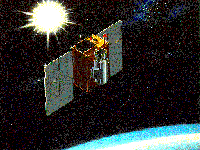|
|
Cosmic Ray Astronomy Satellites & Missions
A brief discussion of the Highlights of Cosmic Ray Astronomy
Satellites is available below. You can find additional information
about this topic in the
"History" section of the Cosmic and Heliospheric Learning Center (http://helios.gsfc.nasa.gov/history.html).
We have tried here to focus on missions which detected non-solar cosmic rays
(intentionally or not).
1912
Cosmic ray research began in 1912 when Victor Hess, of the Vienna University, and 2 assistants flew in a balloon to an altitude of about 16,000 ft. They discovered evidence of a very penetrating radiation (cosmic rays) coming from outside our atmosphere. In 1936, Hess was awarded the Nobel prize for this discovery.
September 21, 1932
Dr. Robert A. Millikan of Caltech, winner of the 1923 Nobel prize in physics, completed a series of tests on the intensity of cosmic rays at various altitudes in a Condor bomber from March Field, Calif.
March 9, 1940
A Beechcraft AD-17 biplane was flown to an altitude of 21,050 ft over the Antarctic to measure cosmic rays for the U.S. Antarctic Expedition.
August 16, 1947
Physicist Martin Pomerantz announced at Swarthmore College that he had sent a flight of four free balloons, carrying cosmic ray equipment, to a record height of at least 127,000 feet over the Antarctic.
May 11, 1950
A U.S. Naval Research Lab (NRL) Viking research rocket was fired from the U.S.S. Norton Sound near Jarvis Island in the Pacific, at the intersection of the geographic and geomagnetic equators, to collect cosmic ray and pressure and temperature data.
1957
The State University of Iowa completed "Rockoon" (balloon-launched rocket) research at high latitudes which had begun in 1952. James A. Van Allen reported that scientific measurements had included:
- the first survey of total cosmic-ray intensity at high altitude and high latitude
- a survey of latitude variation of heavy nuclei in primary cosmic radiation
- the discovery of X-radiation associated with aurorae
- measurement of ultraviolet and soft X-radiation during solar flares
- first measurements of terrestrial magnetic fields at high altitudes in the auroral zone.
U.S. scientific satellite equipment, including a radio transmitter and instruments for measuring temperature, pressure, cosmic rays, and meteoric dust encounters, was tested above Earth for the first time, as a rocket containing this equipment was fired by the Navy to a 126-mile altitude.
 |
September and October 1959
Konstantin Gringauz (USSR) flew "ion traps" on the Soviet Luna 2 and 3 missions, instruments measuring the total electric charge of arriving ions. He found that the signal fluctuated as the spacecraft spun around its axis, suggesting an ion flow was entering the instrument whenever it faced the Sun.
More about Luna 2 (http://nssdc.gsfc.nasa.gov/cgi-bin/database/www-nmc?59-014A)...Luna 3... (http://nssdc.gsfc.nasa.gov/cgi-bin/database/www-nmc?59-008A) |
October 13, 1959
Explorer VII was launched into an Earth orbit. By late December, data from the satellite indicated possible relationships between solar events and geomagnetic storms, and revealed information about trapped radiation and cosmic rays near the Earth.
July 31, 1961
NASA began funding of balloons, launching services, and related expenses in connection with high-altitude measurements of electron, low-energy proton, and alpha-particle spectrum of primary cosmic radiation to be conducted by the University of Chicago from Uranium City, Saskatchewan, Canada.
1961
Herbert Bridge, with Bruno Rossi and the MIT team, obtained more detailed observations with an elaborate trap on NASA's Explorer X, a spacecraft designed to explore the nightside tail of the magnetosphere which was often immersed in the solar wind.
August 17, 1961
NASA announced that Explorer XII had successfully completed its first orbit, radioing data on magnetic fields and solar radiation from an apogee of nearly 54,000 miles and perigee within 170 miles of the Earth.
November 19, 1961
The Navy Skylark balloon began a coast-to-coast flight carrying University of Chicago cosmic ray experiment. It was launched at Brawley, Calif., and landed near Asheville, N.C., on November 21.
October 26, 1973
IMP-8 was launched on a Delta rocket by NASA to measure magnetic fields, plasmas, and energetic charged particles (e.g. cosmic rays) of the Earth's magnetotail and magnetosheath and of the near-Earth solar wind. IMP-8 continues to operate to this day in its near-circular, 12-day orbit. Its orbit is half the distance to the moon. It continues to accumulate a long-time series database useful in understanding long-term solar processes.
More about the IMP-8 spacecraft... (http://nssdc.gsfc.nasa.gov/space/imp-8.html) |
 |
 |
October 1975
GOES (Geostationary Orbiting Environmental Satellite) began to monitor the Sun's surface for outbursts and therefore warn us. This early warning can give us on Earth a few hours to prepare for potentially harmful effects.
More about GOES... (http://climate.gsfc.nasa.gov/~chesters/goesproject.html)
|
1977
The Voyager 1 and 2 spacecraft, both launched in 1977, embarked on an interstellar mission, with a goal of exploring the solar wind termination shock and the heliopause beyond. Scientists believe Voyager 1 entered the region of the shock in early 2003.
More about the Voyager spacecraft... (http://voyager.jpl.nasa.gov/mission/interstellar.html)
|
 |
 |
July 1992
The SAMPEX (Solar Anomalous and Magnetospheric Particle Explorer) mission was launched. It carries instruments in a polar orbit around the Earth, sampling both interplanetary and magnetospheric particles every orbit. These studies contribute to understanding the process of nucleosynthesis. They allow examination of the history and evolution of the galaxy and the solar system, as reflected in their composition, and aid in understanding the acceleration of particles on a variety of scales.
More about SAMPEX... (http://lepsam.gsfc.nasa.gov/www/sampex.html)
|
July 1992
The IMAX (Isotope Matter-Antimatter eXperiment) balloon-borne superconducting magnet spectrometer was launched. It measured galactic cosmic ray abundances of protons, anti-protons, hydrogen, and helium isotopes.
More about IMAX... (http://lheawww.gsfc.nasa.gov/docs/gamcosray/hecr/imax.html)
|
 |
 |
August 25, 1997
Advanced Composition Explorer (ACE) was launched! The ACE project
sponsors the Cosmic and Heliospheric Learning Center (http://helios.gsfc.nasa.gov).
LOTS more about ACE... (http://www.srl.caltech.edu/ACE/)
|
Additional Space History Resources
- Some Dates in the Exploration of the Magnetosphere (http://www-spof.gsfc.nasa.gov/Education/whchron.html) -- NASA/GSFC
- NASA Timeline (http://www.hq.nasa.gov/office/pao/History/timeline.html)
|
